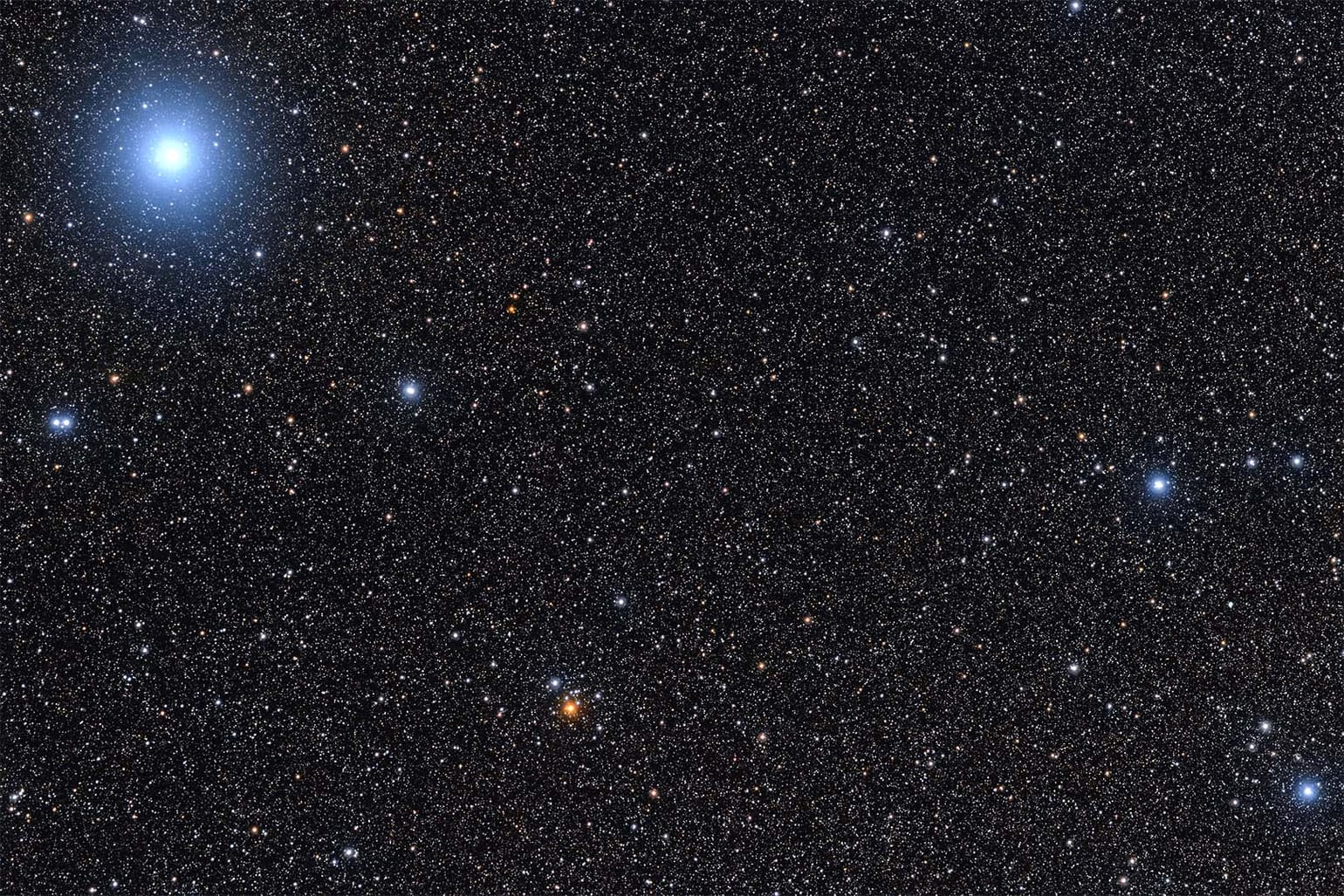Vega Star Facts – The Brightest Star in Lyra Constellation
Vega is one of the most studied stars, which still has enough to surprise us. In this article, you will learn how to spot Vega in the sky and explore what makes it such a fascinating object of study.
Contents
- Why is Vega so important?
- Vega (Alpha Lyrae) – key star facts
- Where is the star Vega – constellation Lyra
- Vega myths
- Fun star facts about Vega
- Bottom line
Why is Vega so important?
For thousands of years, the star Vega has been observed by humans, with records found in ancient Chinese, Arabic, and Greek astronomy. In recent history, astronomers chose it as a reference point for measuring other stars’ color and apparent brightness. Today, scientists are studying Vega to learn about the early stages of stellar evolution and to search for exoplanets. As a bonus, Vega will be the next brightest Polar Star. Read on to find out some of its main features.
Vega (Alpha Lyrae) – key star facts
- Official name: Alpha Lyrae, α Lyr
- Alternative names: Wega, Alf Lyr, Al-Waqi'
- Catalog designations: HIP 91262, HR 7001, HD 172167, TYC 3105-2070-1
- Constellation: Lyra
- Star type: class A0V main-sequence star
- Right ascension: 18 h 36 m 56.3 s
- Declination: +38° 47′ 01″
- Mass: 2.1 solar masses
- Luminosity: 40.12 L (37 times brighter than the Sun)
- Radius (polar/equatorial): 1.64 million km (1.02 million miles) / 1.96 million km (1.22 million miles), or 2.362 / 2.818 solar radius
- Temperature: 9,600 K
- Distance from the Earth: 25 light-years
- Rotation period: 12.5 hours
Is Vega the brightest star in the sky?
No, the brightest star in the night sky is Sirius. In the Northern Hemisphere, Vega is the 3rd brightest star, after Sirius in Canis Major and Arcturus in Bootes. Considering the entire night sky, it gives way to Canopus in Carina and Alpha Centauri in Centaurus. This makes it the 5th brightest star in all.
If you check Vega’s apparent brightness in a stargazing app like Sky Tonight, you’ll see that its magnitude equals zero. However, this doesn't mean Vega has no brightness. It means that it serves as the zero point for a scale of stellar magnitudes that includes positive and negative numbers. Vega was used as an absolute reference for the magnitudes of other stars until the late 20th century. Today, more precise calculations show Vega’s magnitude as +0.026, but it’s still rounded to zero for amateur observations.
Watch our short video tutorial to learn how to explore the characteristics of the stars and other celestial objects in Sky Tonight.
The apparent brightness of the stars depends on their size, temperature, and distance from us. Vega hit the jackpot: it’s so bright because it's big, hot, and close to the Earth. Vega has a diameter of about 2.8 times that of the Sun and a surface temperature of more than 1.5 times that of the Sun. It is also located about 25 light-years from the Earth – a very close neighborhood for a star.
Get to know all the brightest stars in the sky with our colorful infographic.

Vega star color
Vega is a bluish-white star classified as A0V:
- The letter “A” denotes its surface temperature of about 10,000 K.
- The number 0 indicates that it’s the hottest among the 10 subclasses in its spectral type.
- The letter “V” indicates that it’s a main sequence star going through its main phase of life as it fuses hydrogen into helium.
Vega is traditionally the zero point for the color index in the UBV system. The zero point in the system is “white”; stars with negative color indexes are called “blue,” and those with positive indexes are “red.” But if so, why do we say Vega is bluish-white instead of pure white? The reason is that the spectral characteristics of the stars don’t consider illumination conditions in the Earth’s atmosphere, so its bluish tint is due to how our atmosphere affects the light we see.

How old is Vega?
Vega is about 455 million years old. That’s one-tenth the age of the Sun, but it’s aging much faster. Both stars are already in the middle of their main-sequence lifespan, but Vega is expected to burn out in the next 450 million years, while our Sun will survive for another 4.5 billion years.
How fast does Vega spin?
Vega rotates on its axis about once every 12.5 hours. By comparison, the Sun takes 27 days to complete a full rotation. Spinning so fast makes Vega cooler and wider at its equator.

Where is the star Vega – constellation Lyra
Vega is the brightest star of the Lyra constellation, one of the smallest constellations in the night sky. It is also part of a larger asterism known as the Summer Triangle. It’s easy to find Vega and other stars with stargazing apps like Sky Tonight. Read on to get the step-by-step guide.
Where is Vega in the sky tonight?
Vega can be observed almost directly overhead during midsummer nights at mid-northern latitudes. At other times of the year, it’s still visible at night in the Northern Hemisphere but stays lower above the horizon. In the Southern Hemisphere, the star appears low in the northern sky, visible from April to late September.
How to find Vega star – the Summer Triangle star
To find Vega in the sky, look for the Summer Triangle, a prominent asterism made up of Vega in Lyra, Altair in Aquila, and Deneb in Cygnus. Vega is the brightest of the three and can be seen as a bright bluish-white star. In the summer of the Northern Hemisphere, it rises in the east right after it gets dark. It’s hard to confuse it with anything else because Vega is the brightest star in that direction. Once you’ve found it, look to the lower right for Altair and to the lower left for Deneb. In the Southern Hemisphere, the Triangle will appear upside down, rising low on the northern horizon.
Check out our easy-to-find stars infographic for a visual representation.

How to locate Vega with the Sky Tonight app?
You can quickly locate Vega with the help of the stargazing app Sky Tonight by following these simple steps:
- Open the app’s search bar and type “Vega.”
- Tap the blue target button to the right of the matching result. The app will show you the star's position on the sky map.
- Tap the blue compass button at the bottom right of the screen. The app will use your device’s location to align the screen image with the real sky above you.
- Move your device following the white arrow until you see Vega on the screen and in the real sky.

Vega myths
Vega was mentioned in many ancient myths, including Chinese, Japanese, Indian, Greek, and Arabic. Some of these myths have left their marks on the name of the star and its constellation.
Arabic name – falling eagle
The name Vega came from the Bedouin Arabic expression “an-nasr al-wāqi',” meaning “the swooping eagle or vulture,” where “wāqi'” refers to “falling” or “swooping.” Along with its partner, Altair, known as “the flying eagle or vulture,” Vega was famous in Arabian astronomy since the early 6th century CE. They were mentioned in various texts and poetry.
Greek myth – the Harp star
The ancient Greeks called Vega and its constellation “Lyra” or “the Harp.” According to the myth, this celestial lyre was a musical instrument belonging to Orpheus, the legendary musician. After Orpheus was killed, Zeus sent an eagle (Aquila) to retrieve the harp, and both were placed in the sky.
Love story of Altair and Vega
A celestial couple of Altair and Vega inspired beautiful love stories in Chinese, Japanese, and Korean cultures. In Chinese folklore, Altair represents Niulang, a cowherd, and Vega represents Zhinü, the weaving girl. The two fell in love but were separated by the Milky Way, or Celestial River, and were only allowed to meet once a year on the seventh day of the seventh lunar month at the time of the Qixi Festival. In a similar Japanese legend, the couple was allowed to reunite once a year during the Tanabata festival. And in the Korean version, the lovers reunite once a year during the Chilseok festival.

Fun star facts about Vega
The first star to be photographed
On July 17, 1850, Vega became the first star other than our Sun to be photographed. Astronomers James Adams Whipple and William Cranch Bond captured the star using the daguerreotype technique. They focused Vega's light on a photosensitive silver-plated copper sheet and exposed it for about 20 minutes using the 15-inch refractor at Harvard College Observatory.
Over two decades later, in August 1872, the star made history again. This time, amateur astronomer Henry Draper photographed Vega's spectrum. The breakdown of Vega's light into its component colors helped scientists reveal its chemical composition.

Vega may have a planet
In recent years, astronomers discovered that Vega may have a large asteroid belt similar to our own Solar System’s Asteroid and Kuiper belts. The data revealed two distinct belts around Vega: a warm inner belt and a cool outer belt, with a gap in between. Scientists believe that this gap could be home to multiple planets orbiting the star.
A study published in The Astronomical Journal suggests that evidence has been found for at least one such planet. This planet is believed to be as large as Neptune or Uranus and as close as Mercury to our Sun. Moreover, it’s supposed to be incredibly hot, with a temperature of 2,977 °C (5,390 °F), making it the second-hottest discovered planet. However, further research is needed to confirm these findings.
Our past and future North Star
Our modern Polaris seems motionless, but it slowly shifts across the sky in a circuit that takes about 26,000 years, giving way to other stars near the north celestial pole. This motion is due to the precession of the Earth's axis. Around 12,000 BCE, the Paleolithic people observed Vega as the North Star instead of Alpha Ursae Minoris. And in the future, by around 13,600, Vega will become the North Star again.
Waymark to the Lyrid meteor shower
Vega is a reference point to see one of the prolific meteor showers – April Lyrids. The star shines near the shower’s radiant, so check that it’s high above the horizon to determine the ideal time for catching the “shooting stars.”
Bottom line
Vega is one of the brightest stars in the sky and plays a unique role in astronomy. For a long time, it was the absolute reference for the brightness and color of stars, and now it continues to be studied because it may have a planet. In 13,000 years, it will be the new North Star, the brightest of the following millennia. Get to know this brilliant star better and find it in the sky above you with the help of Sky Tonight!
